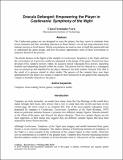Dracula Defanged: Empowering the Player in Castlevania: Symphony of the Night
Author(s)
Fernandez-Vara, Clara
DownloadDracula defanged.pdf (325.9Kb)
PUBLISHER_POLICY
Publisher Policy
Article is made available in accordance with the publisher's policy and may be subject to US copyright law. Please refer to the publisher's site for terms of use.
Terms of use
Metadata
Show full item recordAbstract
The Castlevania games are not designed to scare the player, but they resort to elements from horror literature and film, including references to Bram Stoker’s novel and using characters from monster movies as level bosses. Horror conventions are used as cues to build the gameworld and to understand the game design, and how the player appropriates some of those conventions to empower herself in the process.
The article focuses on the figure of the vampire in Castlevania: Symphony of the Night, and how the conventions set in previous media are integrated in the design of the game. Dracula has been divested of his vampiric powers; rather, he acquires typical videogame boss powers, launching fireballs and teleporting himself within the screen. The powers lost by Dracula as a videogame boss are picked up and amplified by the player character, the half-vampire Alucard. This shift is the result of a process started in other media. The powers of the vampire have now been appropriated by the player as a means to empower their interaction in the gameworld, making the vampire a desirable character to the player.
Date issued
2010Department
Massachusetts Institute of Technology. Program in Comparative Media Studies/WritingJournal
Loading...
Publisher
Simon Fraser University
Citation
Fernandez-Vara, Clara. "Dracula Defanged: Empowering the Player in Castlevania: Symphony of the Night." Loading..., Vol. 4, No. 6 (2010).
Version: Author's final manuscript
ISSN
1923-2691